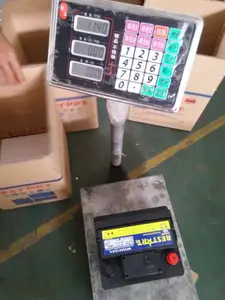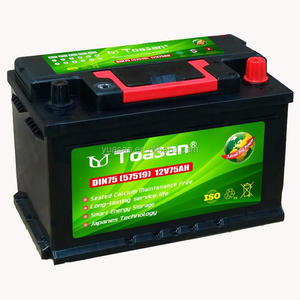Types of MF Starting Car Batteries
Starting batteries are also known as cranking batteries. Their sole purpose is to start the engine of the car. These batteries have a high CCA rating (cold-cranking amps) and discharge a lot of energy in a short time. They come in various types, including:
- Lead-acid batteries: These are the most common types of batteries used in cars. They are affordable and very reliable. Lead-acid batteries are also called flooded batteries. They derive their name from the electrodes and the electrolyte (which is sulfuric acid). The electrolyte is responsible for the discharge and charging of the battery. Lead-acid batteries have 12 volts made of six cells, each with 2 volts. The six cells are connected in series to create a higher voltage. There are two types of lead-acid batteries: starting and deep-cycle batteries. Starting batteries deliver a high burst of current for short periods, while deep-cycle batteries provide a steady current over a longer period.
- AGM batteries: Absorbed Glass Mat batteries are a type of lead-acid battery. AGM batteries use fiberglass mats between the positive and negative plates to absorb the electrolyte. The fiberglass mats trap the electrolyte, making it possible for the battery to be fully charged and discharged. This improves the efficiency and performance of the battery. AGM batteries are maintenance-free and can be installed in various positions. They are durable and have a long lifespan. AGM batteries have a high CCA and can handle deep cycling.
- Gel batteries: These are also maintenance-free lead-acid batteries. The electrolyte in gel batteries is in a gel form, which is created by adding silica to the sulfuric acid. The gel acts like a separator between the positive and negative plates, preventing short circuits. Gel batteries are highly resistant to corrosion and can endure extreme temperatures. They also have a slow discharge rate and are ideal for deep cycling.
- Lithium-ion batteries: Lithium batteries have a high energy density, which means they can store more energy in a smaller space compared to lead-acid batteries. They also have a higher voltage output (3.6 volts per cell) than lead-acid batteries. Lithium batteries are lightweight, have fast charging and discharging rates, and a longer cycle life. However, they are more expensive than lead-acid batteries. Due to their high voltage, lithium batteries are often used in hybrid electric vehicles.
Specification and maintenance of mf starting car batteries
Understanding the specifications of an mf battery is crucial for choosing the right one for a specific car and application. Here are the key specifications:
- Cold Crank Amperage (CCA): CCA is the current a battery can deliver for 30 seconds at 0°F while maintaining at least 7.2 volts. It is a vital consideration for starting batteries; the higher the CCA rating, the greater the starting power. CCA is important in cold climates where winter starts are difficult. A battery with a higher CCA is preferred for trucks and larger vehicles.
- Cranking Amp (CA): CA is similar to CCA, but the rating is determined at 32°F. Since CA is measured at a higher temperature, the ratings are always higher than CCA ratings. CA is critical for starting batteries in regions with warm climates.
- Voltage: mf batteries have a nominal voltage of 12 volts, which is the standard for most vehicles. The voltage is important for compatibility with the vehicle's electrical system.
- Capacity: Starting batteries have lower capacity ratings than deep cycle batteries. The capacity is measured in amp-hours (Ah). An mf battery has an Ah capacity of 60 to 80Ah.
- Size: Starting batteries come in different sizes, such as Group 24, 27, and 31. The battery size is vital for fitting the battery in the vehicle's battery tray. The battery size also affects the CCA rating; larger batteries have higher CCA.
- Terminal Configuration: The location of the battery terminals is important for connecting the battery to the vehicle's electrical system. mf starting batteries have top-post terminals.
Proper maintenance is important for maximizing the lifespan and performance of mf starting batteries. Here are the maintenance requirements:
- Regular Inspection: Users should periodically inspect the condition of the battery and its terminals. The condition inspection will identify any signs of corrosion, leakage, or damage. The battery case and terminals should be clean and free of corrosion.
- Clean Terminals: Battery terminal corrosion can affect the current flow, resulting in weak battery power. The terminals should be cleaned at least once a month using a mixture of baking soda and water. Corrosion should be removed using a wire brush.
- Proper Tightening: Users should ensure that the terminals are properly tightened to prevent loose connections.
- Electrolyte Level: The electrolyte level in flooded mf batteries should be checked regularly. The level should be at the manufacturer's recommended level. Topping up with distilled water is necessary if the level is low.
- Clean Battery Case: The battery case should be cleaned regularly to prevent the accumulation of dirt and grime.
- Temperature Control:mf starting batteries should be stored and used within the manufacturer's recommended temperature range. High temperatures can damage the battery, while low temperatures can reduce its performance.
How to choose mf starting car batteries
Choosing the right battery for a car is crucial in ensuring it meets the power needs of the car and lasts a long time. When sourcing mf car batteries, buyers should consider the following factors:
-
Cranking Power
The cranking power or CCA of a battery is a crucial factor buyers must consider. CCA is the number of amps a battery can provide for 30 seconds at 32 degrees Fahrenheit while sustaining at least 7.2 volts. The CCA determines how well a battery can start a car in cold weather. The higher the CCA, the better. However, users also need to consider the location's average temperature. A battery with a high CCA is not necessarily ideal for all situations. Buyers can therefore offer batteries with different CCA ratings to meet various customers' needs.
-
Battery Size
mf batteries come in different sizes and styles. The size of the terminal post is also different. When choosing an mf battery, buyers should consider the type of car and the battery's compatibility. The battery chosen should fit well in the battery tray and also power the car effectively. A properly fitted battery will provide a good connection and vibration resistance.
-
Deep Cycle vs Starting Batteries
Buyers should consider who their customers are and what their needs are. If the customers are looking for batteries for regular cars, they should go for starting batteries. On the other hand, if the customers are looking for batteries for recreational vehicles or solar systems, they should source deep cycle batteries.
-
Brand Reputation
Buyers should do their research and find reputable mf battery suppliers. They should read reviews to find out customers' experiences with the products. A well-known brand may provide quality products and a good warranty.
-
Terminal Orientation
When choosing an mf battery, buyers should consider the battery's terminal orientation. The positive and negative terminals should be in the correct position to power the car effectively. A battery with the wrong terminal orientation may not work well.
How to DIY and Replace Mf Starting Car Batteries
Replacing an mf battery can be a straightforward DIY task. However, it's crucial to ensure safety and follow the correct procedures. Here's a step-by-step guide on how to replace an mf battery safely:
- Gather necessary tools: Before starting, gather the necessary tools for the replacement. These tools include a wrench, a battery terminal cleaner, and gloves. Additionally, purchase a new replacement battery that suits the vehicle's specifications.
- Safety precautions: Ensure that the vehicle is parked in an open, well-ventilated space away from flammable materials. Turn off the ignition and all electrical components in the vehicle, such as lights and radios. Wear protective gear like gloves and goggles to protect against battery acid and reduce the risk of electrical shock.
- Disconnect the old battery: Open the hood and locate the battery. Use a wrench to loosen the nuts on the battery terminals. Disconnect the negative terminal first and place it away from the battery. Next, disconnect the positive terminal and keep it away from the battery.
- Remove the old battery: Remove any clamps or brackets holding the battery in place. Carefully lift the battery out of the battery tray. Mf batteries can be heavy, so it's advisable to seek help when lifting the battery.
- Clean the battery terminals: Use a battery terminal cleaner to clean the terminals. Cleaning the terminals prevents the accumulation of corrosion, which can affect the battery's performance.
- Install the new battery: Place the new battery in the battery tray, ensuring it sits in the correct orientation. Reinstall any clamps or brackets to hold the battery in place. Take care to avoid over-tightening the clamps, which can damage the battery.
- Reconnect the battery: Reconnect the battery terminals, starting with the positive terminal. Ensure the connections are tight and secure to prevent battery leaks. After reconnecting the terminals, double-check to ensure the connections are tight and secure.
- Check the vehicle's electrical system: Turn on the vehicle and check that all electrical components are functioning correctly. If there are any issues, double-check the battery connections and ensure they're properly connected.
Q and A
Q1: Are mf batteries good for starting?
A1: Yes, MF batteries are good for starting. They are designed to provide a strong initial current to start the engine, even in challenging conditions.
Q2: How long do mf batteries last?
A2: The expected lifespan of MF batteries is typically 3 to 5 years. However, proper maintenance and usage can extend their lifespan.
Q3: Can I use an mf battery in any vehicle?
A3: MF batteries can be used in most vehicles. However, choosing a battery that matches the vehicle's specifications and requirements is essential.
Q4: Are mf batteries maintenance-free?
A4: Yes, MF batteries are maintenance-free. They do not require regular water topping or other maintenance, making them convenient for users.
Q5: What does mf mean in batteries?
A5: The abbreviation "mf" in batteries denotes "maintenance-free." It indicates that the battery requires no regular maintenance to function correctly.



























































































































































































